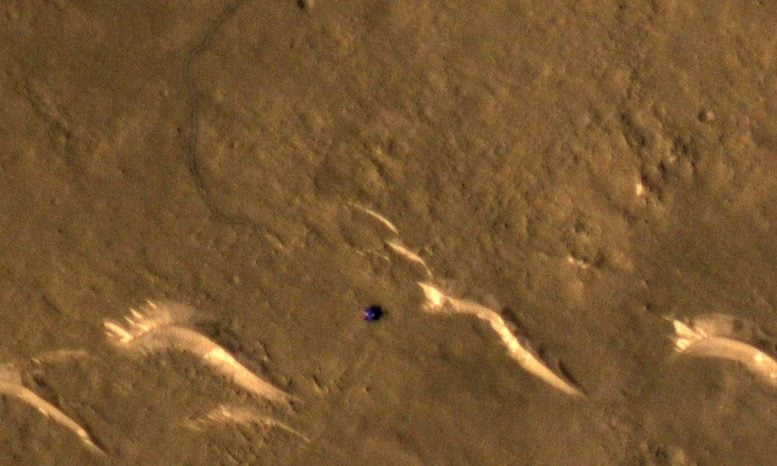هبطت مركبة الإنزال الصينية Tianwen-1 ومركبة Jurong الجوالة على الكوكب الأحمر في 14 مايو 2021 ، لتلامس سهولتي Utopia و Planesia لمدة ثلاثة أشهر تقريبًا. وكالة الفضاء الصينية تشارك صور روفر وهبوط (بما في ذلك صورة عائلية جميلة تم التقاطها بواسطة كاميرا لاسلكية عن بعد)[{” attribute=””>NASA’s Mars Reconnaissance Orbiter has been following the rover’s travels from above.

Tianwen-1 Lander and Zhurong Rover in Southern Utopia Planitia shortly after landing in May 2021. Credit: NASA/JPL/UArizona
Early on in the Zhurong mission, the HiRISE camera on MRO spotted the lander and rover, as seen from orbit. Our lead image is the latest view from HiRISE, showing the rover’s path and new location, letting us follow along on how far the rover has traveled in the 10 months since it landed. This image was acquired on March 11, 2022.
This tweet from the HiRISE teams shows views of various hardware on Mars surface from China’s mission, such as the lander and backshell.
In case you missed the other parts of today’s HiPOD observation (linked in the text). pic.twitter.com/ZhuZxxmBGM
— HiRISE: Beautiful Mars (NASA) (@HiRISE) March 18, 2022
But in this image below shows Zhurong’s entire trip, and if you look closely (click this link to be able to zoom into the image) you can even see the rover tracks. The HiRISE team wrote on their blog that “It’s exact path can be traced from the wheel tracks left on the surface. It has traveled south for roughly 1.5 kilometers (about 1 mile). “ The imaging team has actually added contrast so that the tracks are more visible.

HiRISE image showing tracks and the most current imaged location of the Zhurong rover. Credit: NASA/JPL/UArizona.
Like most Mars orbiting cameras, HiRISE acquires images in long, thin strips. Because of how the camera detectors are set up — with 10 detectors lined up in an array — each strip covers about 5 kilometers wide. But HiRISE has two extra pairs of detectors on the two middle strips to get color data, so there’s a central color swath about 1 kilometer wide.
MRO orbits about 316 km (250 miles) above the Martian surface. At this altitude it can take pictures of Mars with resolutions of 0.3 m/pixel (about 1 foot); therefore it can resolve objects less than a meter across. With that type of power, it can spot the various Mars landers and rovers on the surface, including Opportunity, Curiosity, and Perseverance. HiRISE even captured Curiosity and Perseverance as they were descending under parachutes to the surface.

The Mars 2020 descent stage holding NASA’s Perseverance rover can be seen falling through the Martian atmosphere, its parachute trailing behind, in this image taken on February 18, 2021 by the HiRISE camera on the Mars Reconnaissance Orbiter. Credit: NASA/JPL-Caltech/University of Arizona
Richard Leis, a member of the HiRISE team said on Twitter that because of the amount of territory covered by the HiRISE image strips, it always takes time and skill to spot human-placed artifacts on Mars’ surface:
These @HiRISE observations are so huge, it takes some practice to spot the Earth hardware sitting on the Martian landscape. That’s one of the jobs of my small validation team: they search the image for the expected hardware and record the x- and y-coordinates. https://t.co/wmXMqx38st
— Richard Leis ✍️📚🏳️🌈🪐🎃 (@richardleisjr) March 18, 2022
Originally published on Universe Today.

“متعصب التلفزيون. مدمن الويب. مبشر السفر. رجل أعمال متمني. مستكشف هواة. كاتب.”








More Stories
خريطة جديدة للمريخ تكشف عن “هياكل” مخفية تحت سطح المريخ
زوج من نفاثات البلازما الضخمة تندلع من ثقب أسود هائل | الثقوب السوداء
الأسمنت المستوحى من عظام الإنسان أصعب بخمس مرات من الخرسانة العادية